Drag
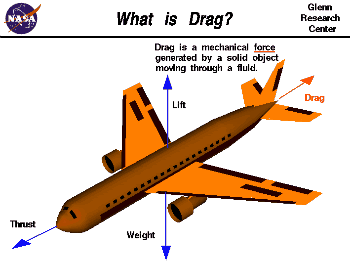
The aerodynamic resistance experienced as a solid object travels trough the air.
The remarkable speed of the F1 racecar is achieved from the careful combination of its powerful engine and expertly crafted aerodynamic body features. In the early years of F1 design, the engine was the primary variable in determining the racing success of a car. Applicable engine technology had far exceeded the maturity of vehicle aerodynamics.
Those historic years embodied a simple algorithm. Speed was nearly a direct function of horsepower. Although still improving almost annually, engine performance levels among the cars of each racing season today have comparable performance – record speed achievements now hinge on a different design issue - aerodynamics and drag plays a major role.
F1 aerodynamics engineer, Will Gray, has noted that "Top speed is determined other factors (car weight, fuel strategy, and good low-end engine power), but the main factor which separates the victors from the valiants in this area is aerodynamic performance – too much drag and you're pulling unwanted air along with you.
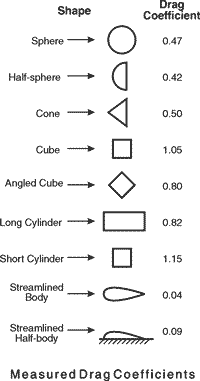
One form of drag occurs as air particles pass over a car's surfaces and the layers of particles closest to the surface adhere. It's known as Boundary layer drag or Skin Friction Drag. Skin friction drag is caused by the actual contact of the air particles against the surface of the moving object.
The layer above these attached particles slides over them, but is consequently slowed down by the non-moving particles on the surface. The layers above this slowed layer move faster. As the layers get further away from the surface, they slow less and less until they flow at the free-stream speed.
The area of slow speed, called the boundary layer, appears on every surface, and causes one of the three types of drag.
The force required to shift the molecules of air out of the way creates a second type of drag, Form Drag. Due to this phenomenon, the smaller the frontal area of a vehicle, the smaller the area of molecules that must be shifted, and thus the less energy required to push through the air. With less engine effort being taken up in the moving air, more will go into moving the car along the track, and for a given engine power, the car will travel faster. Form drag and pressure drag are virtually the same type of drag. The separation of air creates turbulence and results in pockets of low and high pressure that leave a wake behind the airplane, car or airfoil (thus the name pressure drag). This opposes forward motion and is a component of the total drag. Streamlining the moving object will reduce form drag, and parts of an racing car that do not lend themselves to streamlining are enclosed in covers called fairings.
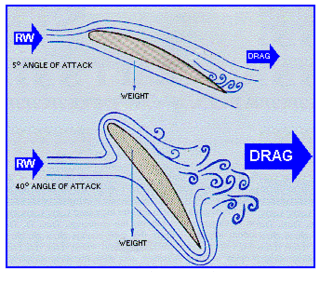
Another factor that plays a role in aerodynamic efficiency is the shape of the car's surfaces. The shape over which air molecules must flow determines how easily the molecules can be shifted. Air prefers to follow at surface rather than to separate from one. The term "separation" refers to the smooth flow of air as it closely hugs the surface of the wing then suddenly breaking free of the surface and creating a chaotic flow. Interestingly, researchers of aerodynamics have found the 'teardrop' shape, round at the front and pointed at the back, to be most efficient at propelling through air while providing a suitable surface for the air to easily move across. With this shape there is little or no separation. It is important to note that sharp frontal areas, rounded ends, sharp curves or sudden directional changes in a shape should be avoided since they tend to cause separation, which increases drag.

Another type of drag is Induced Drag. It is noted as such because it is caused by or "induced" by the lift on the wings. Induced drag is an unfavorable and unavoidable byproduct of lift (or downforce). You can't do much about induced drag, since you wouldn't have "lift" without it. It occurs on wings of standard or inverted position. In fact, the potential of displaying induced drag exists for all bodies that exhibit opposite pressures on their top and bottom surfaces. Being that air (or any fluid) prefers to move from high to low-pressure regions, air from low-pressure regions has a tendency to curl downward around the ends of a F1 car wings, for example. It travels down from the high-pressure region to the low-pressure region on the bottom of the wing (opposite direction in case of airplane wings) and collides with moving low-pressure air. Wing tip vortices are a result of this situation. Looking from the tail of the airplane, the vortices will circulate counterclockwise from the right wing tip and clockwise from the left wing tip because on airplane wing high pressure area is below the wing. In case of racing car, high pressure area is on the top of the wing, and vortices will circulate in opposite direction. The greater the size of the vortices, the greater the induced drag.
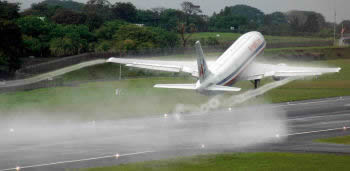

These vortices occur on both airplane wings and F1 car wings even though end plates may be used to reduce this type of drag . It should be noted that the kinetic energy of these turbulent air spirals acts in a direction that is negative relative to the direction of travel intended. In the case of induced drag on F1 cars, the engine must compensate for the losses created by this drag.
A rectangular wing produces much more severe wing tip vortices than a tapered or elliptical wing, therefore many modern airplane wings are tapered. Typically, straight wings produce between 5–15% more induced drag than an elliptical wing. Some early aircrafts and some sport car wings and spoilers has fins mounted on the tips of the wing which served as endplates. More recent aircraft have wing tip mounted winglets or wing fences to oppose the formation of vortices. Designs such as winglet, wing fence , modified wing tip, etc all reduce induced drag. But there is not a system invented yet to prevent it completely.
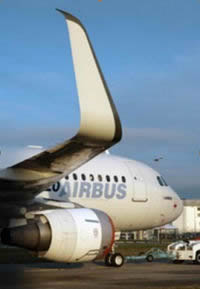
Understanding the relationship between speed and drag is important in calculating maximum endurance and the range of the airplane or racing car. When drag is at a minimum, power required to overcome drag is also at a minimum.
Vortex drag is product of Induced drag. It can be created by both lifting and non lifting bodies (usually of the bluff variety, ex. road vehicles, airships). Vortices are released during flow separation and trail downstream to form structured or unstructured wake patterns.
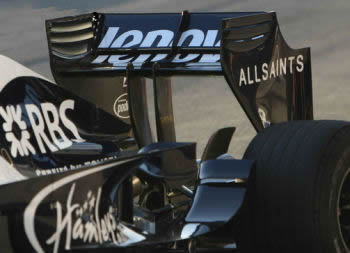
There is another drag type very preset in car racing, and discussed, especially in F1 racing. Interference drag is the effect of the interference of one body on the aerodynamics of a second body. The interference drag is a system drag that is present even in absence of viscous effects (ideal fluid) and non lifting conditions. Since interference occurs in many practical situations interference drag is a separate topic.
The F1 racecar is a complicated aerodynamic system – composed of skin friction, form and induced drag. As result, aerodynamicists typically find it sufficient to estimate an overall coefficient of drag for these cars. The following equation, which incorporates the effects of all three drag types, is used to determine this data.
| F = 0.5CdAV2, where is F - Aerodynamic drag Cd- Coefficient of drag D- Air density A- Frontal area V- Object velocity |
Interestingly, modern F1cars are reported to have Cd values of about 0.85 with corresponding CdA[m2] values near 1.2.1. These values are approximately triple of those for the modern road car, and only a bit higher then typical bus. This is primarily due to three reasons.
The first is that regulations specify features that deter from the ability of a designer to achieve relatively low drag coefficients (i.e. open cockpits and running exposed wheels).
The second reason is likely due to be the fact that F1 cars rely on a balance between drag and downforce in which drag is often sacrificed for necessary downforce. In order to make up for the speed losses due to drag, engine power is increased if possible. Lastly, unlike family sedans, low fuel consumption is not a paramount concern. Therefore, drag coefficients are allowed to be somewhat large, especially since the importance of other factors (i.e. downforce) takes priority.
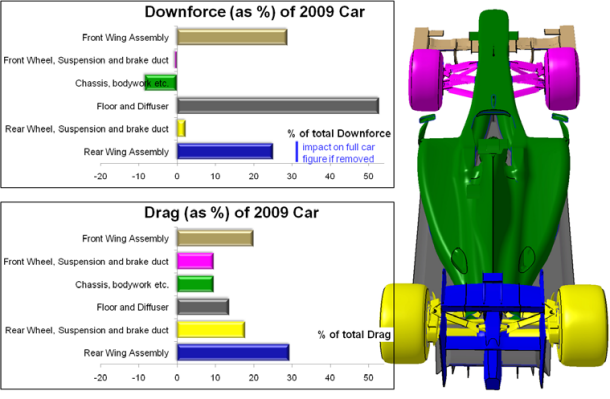 |
Insight into aerodynamics basics – downforce and drag breakdown into major components. (From "Aeronautical Journal Jan 2013", courtesy of Willem Toet, Head of Aerodynamics, Sauber F1 Team, Sauber Motorsport AG) |
Interference drag
Interference drag results when two bodies are too close to each other, such that the flow around one interferes with the flow around the other, with total drag being more than the sum of that from the respective parts tested separately. These phenomena became especially apparent with the development of the DC-3 transport plane in the 1930s. A streamlined fuselage had drag X, and a streamlined wing had drag Y, so arithmetically, X + Y should have meant total drag Z. Turned out, total drag was ~63% more than the sum of the individual fuselage and wing. Wing fillets reduced the interference drag somewhat. Placing two objects adjacent to one another may produce turbulence 50 % to 200 % greater than the parts tested separately.
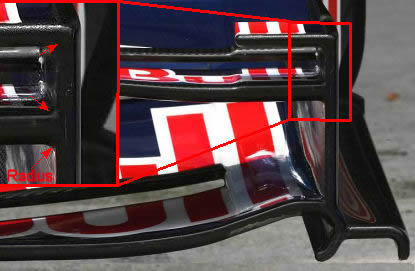 So, we can say that Interference drag is drag generated by the collision of airstreams, creating eddy currents, turbulence, or restrictions to smooth flow. This interference leads to the modification of boundary layers and creates a greater pressure difference between the fore-and-aft areas on the surfaces concerned. This, in turn, leads to greater total drag. Fairings or additional fillets are used to streamline these intersections and decrease interference drag.
So, we can say that Interference drag is drag generated by the collision of airstreams, creating eddy currents, turbulence, or restrictions to smooth flow. This interference leads to the modification of boundary layers and creates a greater pressure difference between the fore-and-aft areas on the surfaces concerned. This, in turn, leads to greater total drag. Fairings or additional fillets are used to streamline these intersections and decrease interference drag.
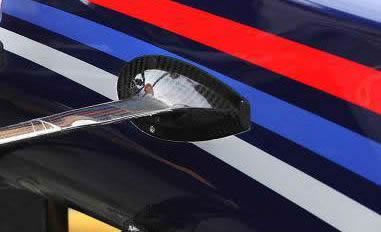 It is customary to refer to drag caused by the parts which are not lift producers as Parasite Drag. Interference drag is a form of parasite drag and becomes very important at high speeds. Parasite drag is divided into three types: form drag, interference drag, and skin friction drag, which are explained before.
It is customary to refer to drag caused by the parts which are not lift producers as Parasite Drag. Interference drag is a form of parasite drag and becomes very important at high speeds. Parasite drag is divided into three types: form drag, interference drag, and skin friction drag, which are explained before.
A body which has no “bumps” or abrupt changes in cross-sectional area along its length will produce less drag than one which has abrupt variations. We then have the concept that high-speed drag of an aircraft will be minimized if the distribution of cross-sectional area, including all parts (wings, fuselage, etc.), is made as smooth as possible. To satisfy this, the cross-sectional area of the fuselage must be reduced in the region of the wing and tail to compensate for the additional cross-sectional area of those surfaces. The term applied to that concept is Area Rule. Area rule is shaping the platform of an aircraft to cause the cross-sectional area to gradually increase and then decrease. Same rule apply for Formula 1 car with different wings, winglets, splitters attached to car body. All transition points (from body to appendages) must be smoothed and adequate transition applied.
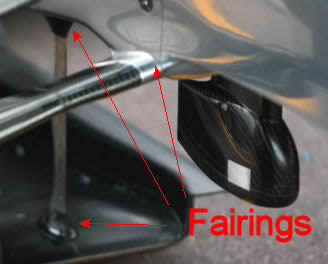 |
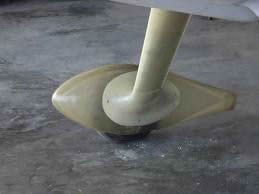 |
Back to the top of the page






